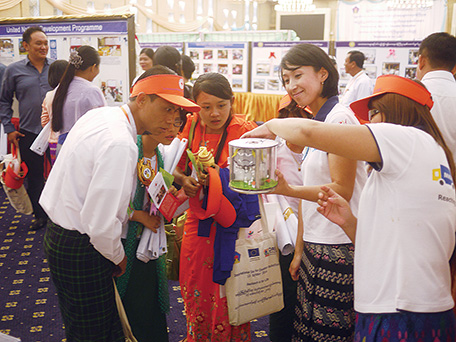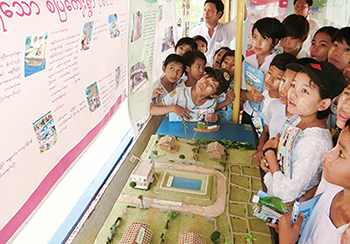Stories from the field 11
Sharing Japan’s Experiences of Fighting against Disasters while Providing Moral Support
– Mobile Disaster Risk Reduction Classroom in Myanmar

Ms. Shikada introduces disaster risk reduction learning tool kits at the 2014 International Risk Reduction Ceremony held in Naypyidaw, Myanmar. (Photo: SEEDS Asia)
In May 2008, Cyclone Nargis struck Myanmar in Southeast Asia with powerful winds of up to 250 kilometers per hour and high tides of up to 3.6 meters, resulting in unprecedented damage and about 140,000 people dead or missing. SEEDS Asia, a registered non-profit organization engaged in disaster relief and disaster risk reduction projects in developing countries, initiated activities in Myanmar in that year. Since 2013, it has worked to improve the disaster risk reduction capabilities of the regions vulnerable to disasters, utilizing the mechanism of the JICA Partnership Program1 receiving support from JICA.
Ms. Mitsuko Shikada, who continues to be active locally, participated as a volunteer in the exchange activities with the children who were orphaned by the Great Hanshin-Awaji Earthquake in Kobe during her time at university. Later, she studied abroad in India and when working at a Japanese trading company in Delhi she learned about the havoc wrought by Cyclone Nargis. Concerned about the situation of the orphaned children, she decided to change her career path and join SEEDS Asia. The next year she was dispatched to Yangon.
The main target areas of her activities are Yangon and Ayeyarwady. These low-lying areas are susceptible to wind and water damage from climate change and tsunami, and suffered greatly as a result of Cyclone Nargis. First, Ms. Shikada was shocked that even the school teachers failed to understand the mechanisms of a disaster and how to respond. The local residents, too, could do nothing but feel fear or had the attitude of simply giving up.
Responding to the situation, SEEDS Asia developed learning materials to foster easy understanding of the basics about disaster risk reduction. This reflected the belief that even if natural disasters cannot be prevented, people can work to minimize the damages they cause. They then loaded these materials onto a truck and commenced school visits using a “mobile disaster risk reduction classroom.” As of September 2015, they had visited over 350 schools reaching more than 30,000 teachers and children. This has made it possible for teachers to teach about disaster risk reduction, and tests have shown that children’s knowledge and awareness of disaster risk reduction has improved significantly, which was also confirmed via monitoring.
“The ‘mobile disaster risk reduction classroom’ was a form of ‘assistance to spread awareness.’ This is because disaster risk reduction knowledge and awareness was not widely known. Now, we are making the shift to ‘grassroots assistance’ for spreading and developing this knowledge and awareness by establishing a center for disaster risk reduction activities,” says Ms. Shikada about the importance of these activities.

Children listen intently to explanations about the ten points for protecting their communities from the risks of tsunami, flooding, cyclones, and earthquakes at a “mobile disaster risk reduction classroom.” (Photo: SEEDS Asia)
After Cyclone Nargis, the national government drew up the Myanmar Action Plan on Disaster Risk Reduction, but this plan included little in the form of assistance to organizations at the local level, and in particular for linkages between schools and communities. Therefore, SEEDS Asia has been establishing centers to serve as the disaster risk reduction hub of local communities in an effort to carry out activities for building networks and capacity improvement for continual disaster risk reduction activities involving linkages between communities and schools.
The area of SEEDS Asia’s activity is in the low-lying delta with huge paddy fields as far as the eye can see. There are nearly no highlands for the people to seek refuge in the event of a tsunami, high tide or powerful storms. There are some locations with an evacuation shelter that was constructed after Cyclone Nargis, but simply having a building is not enough. Efforts in capacity building for disaster risk reduction must be carried out daily. Furthermore, a system for evacuations and disaster risk reduction facilities must be established in order to collect information, determine evacuations based on the actual situation, operate evacuation shelters, and carry out immediate aid and rescue activities.
The project first used the mobile disaster risk reduction classroom to widely share basic knowledge on disaster risk reduction and selected disaster risk reduction leaders from among the teachers and the central figures of the local community who would play a core role in operating disaster risk reduction activity centers. A training plan was created and executed, which highlighted areas and elements with low disaster resiliency and identified required equipment or capacity in preparing for specific risks, in an effort to spread this knowledge within the community.
There are many local residents who do not want to think about cyclones because they lost a loved one in Cyclone Nargis. The fact is that there are countless local residents who are pessimistic and think they are helpless in the face of Mother Nature. This is precisely why Ms. Shikada believes in the importance of sharing Japan’s own history and experience of overcoming natural disasters, and also providing moral support to the local residents.
“We listen carefully to local residents and try to be as thoughtful as possible to take their feelings into account. We show empathy and compassion for those who feel ‘more lives could have been saved,’ ‘I don’t want to lose a loved one,’ or ‘I want to survive disasters.’ We have also appealed to the emotions of local residents and emphasized the importance of being prepared for disasters.”
Results are already emerging. In Kungyangon, where work is progressing on the creation of a center for disaster risk reduction activities as a model case before other communities, the community and schools have worked together and voluntarily initiated activities, conducted disaster risk reduction drills and invited residents from other communities to attend in an effort to raise greater awareness.
The low-lying delta area of Myanmar has begun community-based disaster risk reduction activities involving daily preparations for future disasters. These efforts are being supported behind the scenes by careful assistance from Japan that also involves moral support for the people of disaster-affected areas.
*1 JPP is a part of ODA programs in which JICA supports and jointly implements international cooperation activities for local residents in developing countries with Japanese NGOs, universities, local governments, and organizations such as public interest corporations.
<< Previous Page Next Page >>
Main Text | Statistics and Reference Materials | Stories from the field | Master Techniques, From Japan to the World | ODA Topics
